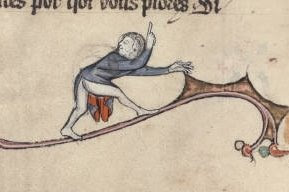For those of you worried that Got Medieval is going to be replaced by Got Marginalia, take heart. I will be back to “real” posts by mid-June at the latest, after I’m all settled into my new place.
This week’s marginalia comes from my old favorite, Yale MS 229, the third volume of a thirteenth-century deluxe set of the complete Old French Vulgate Cycle of Arthurian romances, currently housed at Yale’s Beinecke Manuscript and Rare Books Library. If you’re reading this on my actual site, rather than through a RSS reader, see if you can’t guess what Lancelot’s crossbow is aimed at before expanding the post:
 Did you guess “A peasant’s bared butt?” Here’s the wide-angle shot, so you can see said peasant and said peasant’s butt:
Did you guess “A peasant’s bared butt?” Here’s the wide-angle shot, so you can see said peasant and said peasant’s butt:
 I hate to inform the Lucy Allen-types of the world, but this ass-based joke is a very common in the Middle Ages, which is why, perhaps, we medievalists can be forgiven for being the way we are. You can find images of imminent or just-completed butt-shooting in romances and histories, but also in psalters, missals, and books of hours–pretty much in anything with marginalia, both sacred and secular. In fact, like the Wheel of Fortune from two weeks ago, the crossbow-bolt-to- the-butt joke was such a common image that creative illuminators could exploit their audience’s familiarity with it to make further jokes. Here below is a more standard version of the butt-joke, from the Alexander MS that a reader kindly directed me two a few weeks ago:
I hate to inform the Lucy Allen-types of the world, but this ass-based joke is a very common in the Middle Ages, which is why, perhaps, we medievalists can be forgiven for being the way we are. You can find images of imminent or just-completed butt-shooting in romances and histories, but also in psalters, missals, and books of hours–pretty much in anything with marginalia, both sacred and secular. In fact, like the Wheel of Fortune from two weeks ago, the crossbow-bolt-to- the-butt joke was such a common image that creative illuminators could exploit their audience’s familiarity with it to make further jokes. Here below is a more standard version of the butt-joke, from the Alexander MS that a reader kindly directed me two a few weeks ago:
 Usually, the shooter is no different than the shootee, except for the color of his clothing and the and baredness of his bottom. As well, the shootee usually is depicted holding his robe open, daring the crossbow-wielder to let fly. That second feature, at least, appears to be the original intention with Lancelot’s target. Look closely at his back:
Usually, the shooter is no different than the shootee, except for the color of his clothing and the and baredness of his bottom. As well, the shootee usually is depicted holding his robe open, daring the crossbow-wielder to let fly. That second feature, at least, appears to be the original intention with Lancelot’s target. Look closely at his back:

Those are the pencil lines of the sketch that the illuminator made when he was planning out the page. Originally, the peasant was just holding his robe open, as expected. But when the illuminator went to ink and color his sketch, he decided to improvise a little joke-within-a-joke that fit the page’s final composition.
As I mentioned last week, one of the things that I like most about medieval illuminations is their self-awareness. The marginal peasant depicted here is particularly precocious: He can see the words floating in the air above him and calls Lancelot’s attention to one of them, “cries” (OF plores). It’s an even bet whether this is meant as a further goad to Lancelot (“You’re a crybaby if you don’t shoot”) or as a warning (“Don’t shoot me, or it’ll make me cry.”)
I think the joke goes even further, though, if you follow the peasant’s pointing finger further up the page. If you’ve noticed, I’ve been constantly labeling the knight in blue “Lancelot.” This is because Lancelot is consistently depicted in the main in-text chapter-heading miniatures throughout this section of the narrative as a knight in blue and red, with the same armor and markings as we find here on the marginal shooter.* Our peasant seems to be pointing at one of these in-text miniatures on the page, one where Lancelot encounters a crying maiden whose case is will soon take in the story that follows. Here is that image:
 In effect, the marginal peasant is pointing up at the main text miniature in order to remind the marginal Lancelot that he doesn’t belong down in the margins, as if to say, “You’re not an extra, buddy; you’ve got a starring role up there. Now go, rescue the maiden and joust that dude and leave the ass-shooting to us marginal types. You don’t have time to be slumming down here.”
In effect, the marginal peasant is pointing up at the main text miniature in order to remind the marginal Lancelot that he doesn’t belong down in the margins, as if to say, “You’re not an extra, buddy; you’ve got a starring role up there. Now go, rescue the maiden and joust that dude and leave the ass-shooting to us marginal types. You don’t have time to be slumming down here.”
—
*Unfortunately, there are no errant pencil marks around Lancelot on the left, so I can’t say for certain whether the illuminator originally drew a knight or a peasant in the role of shooter.